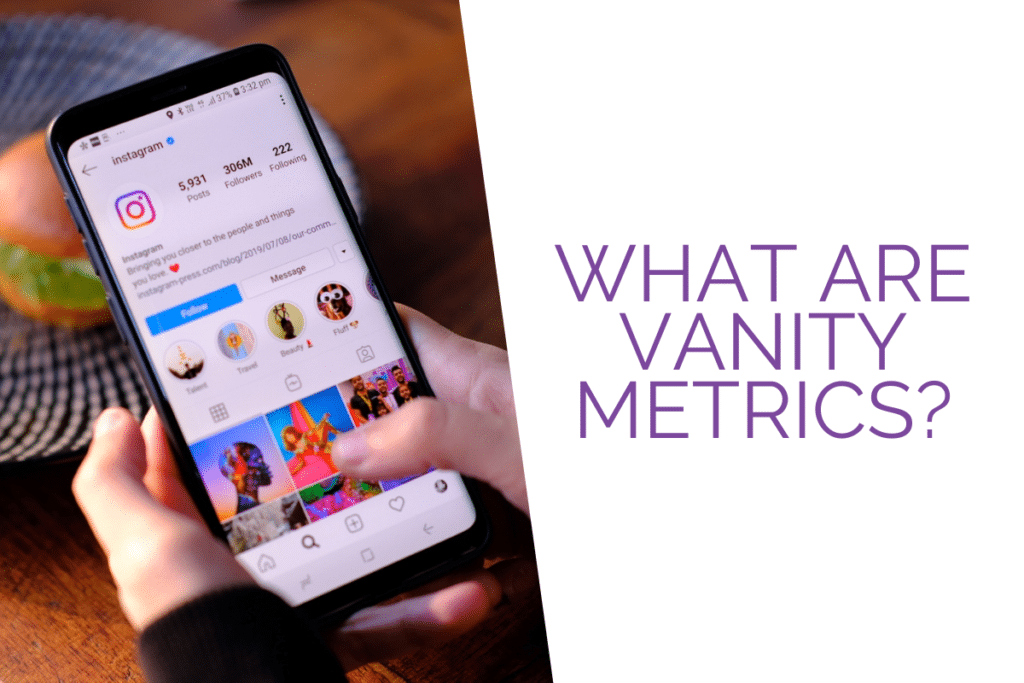So you want more people to recognize your personal brand. I bet that what comes to mind are goals such as: increasing your website traffic, your social media follower count, and even your monthly ad spend. Unfortunately, these are considered vanity metrics, and none of these will help you reach your business goals.
These numbers have always been at the forefront of personal brand marketing. Social media platforms highlight their significance. On YouTube, your subscriber count is prominently displayed on the front page. So is your follower count on Instagram. However, as a CEO, these numbers say and do little for your personal brand’s overall health and success.
Most of these numbers do not reflect the profit or scaleability of your brand. One viral post could boost those numbers, but that doesn’t mean you’ll make sales. And it’s not an indicator that this audience will stick around.
So what’s considered a vanity metric, and what should you be focusing on instead? I’m glad you asked.
What Are Considered Vanity Metrics?
Vanity metrics are numbers that make your personal brand look appealing on social media. They’re easily identifiable because anything your audience can see is a vanity metric: likes, comments, subscribers, and followers.
If you plan to hire a branding or marketing team to boost these numbers— well, you’re in for a big surprise. When you’re working with a personal brand strategist like me, the first thing you’ll learn is how insignificant these numbers really are. While these particular number increases may look nice on monthly reports, this isn’t what I focus on to build your brand’s reputation.
And neither should you.
The metrics below are merely dots on your overall business plan. These numbers cannot be guaranteed (unless they’re purchased), and, more importantly, they don’t equate to more business.
Sure, you should keep track of them; if they’re not growing to some extent, then the content you’re producing clearly does not resonate with your core audience. And that’s a huge problem.
On a large scale, we label these numbers as a vanity metric. Here’s why:
RELATED: What Is Social Media Branding?

Social Likes
Everyone is concerned about the number of ‘likes’ their posts get. That’s because, on the surface, a couple of thousand likes look pretty impressive to the press, your competition, and your consumers.
Besides an ego boost, the number of likes your individual posts get plays a small role in how people are interpreting your personal brand. In 2019, there was an 18% decline in Instagram likes for 6 months. This sudden drop is likely why Instagram decided to hide likes in some countries.
Likes represent actual vanity because we use them as a metric to show how popular our personal brand appears to be. However, 1,000 likes on a post do not mean that 1,000 people are willing to buy from your brand— or even that they like your brand.
It’s become such a frivolous metric that even Adam Mosseri, the head of Instagram, agrees their platform causes too much anxiety. When speaking on the decision to hide this social metric, Mosseri said,
“The idea is to try and depressurize Instagram, make it less of a competition, give people more space to focus on connecting with people that they love, things that inspire them.”
The way social media users are behaving is also drastically changing. A mindless double-tap on your image shows vague interest in your content. But a save or a share shows social media algorithms that someone enjoys your content enough to revisit it later.
RELATED: HOW TO BUILD A REPUTATION WITH YOUR ONLINE PRESENCE
Follower Count
1 million followers, 100,000 followers, or 500 followers.
Which of those numbers looks more impressive?
If you choose the first one, then you’ve fallen victim to vanity metrics.
What if I told you that the personal brand with 1 million social media followers still works at their day job and the person with 500 followers is making $10,000 or more every month?
That is more likely to be the case than the other way around. Follower count does not equate to business (especially when people can so easily purchase followers). The only time this number starts to matter is after you’ve seen an impact on sales, press, and opportunities. And at the point, you know that you’ve built a reliable personal brand, so again, the follower count probably won’t increase those factors.
Imagine this:
You decide to buy followers to make your personal brand look impressive. Any of your current followers who notice this huge spike and recognize what it is. Now let’s assume that nobody noticed, and you’re finally starting to trickle in some legitimate, interested consumers. They’ll see you’re follower count, be mildly impressed, and start going through your content. Once they see that your posts are getting little to no engagement, they’ll begin second-guessing your brand, and it’s authenticity.
Now let’s say that you ethically required a robust follower count, but somewhere down the line, your comments and likes started to dwindle. Your engagement doesn’t match your follower count, and consumers will assume the worst: that you bought followers. This automatically makes your personal brand inauthentic and untrustworthy.
It’s a lose-lose situation.

Website Traffic
This one is difficult to explain to my clients.
Whether you obtain traffic from ads or organic social media referrals, website traffic says a lot about how well your audience reacts to your personal brand’s message. You should be continuously telling your audience to go to your website for your latest sale, blog, or service. If your analytics show that people are going to your website, your personal brand looks like it’s working!
At least on paper.
Website traffic, just like followers and likes on social media, doesn’t reflect how many sales you’re making. You can be getting 10,000 website visitors a month and not make a single penny.
Meanwhile, you can be getting under 5,000 website visitors a month and make $1,000 each month because your copy, service, or product is exceptionally well-received.
We use SEO to boost our client’s website traffic by getting them on Google’s front page. This can increase your personal brand website’s overall performance and help you reach new audiences. However, the website visits are not the only thing we look at (more on that below) because when your website traffic continues to grow, but your sales do not, there’s a problem.
RELATED: 4 REASONS YOU NEED VIDEO CONTENT MARKETING FOR YOUR PERSONAL BRAND
Impressions/Reach
Unlike follows, comments, or likes, your impressions hide in the backend of your social analytics. Each social media platform offers you Insights into your page if you have anything other than a personal or private account. Impressions and Reach are often looked at as a metric showing if your personal brand is reaching people outside your sphere of influence.
For example, on your Facebook page, you can view all of the data behind your account. If you look at your Most Recent Posts, it will show you how they perform based on Reach and Engagement.
At a glance, it might look impressive. Let’s say you’ve reached 20,000 people with just one of your posts. Not bad, right?
However, what you need to look at is your engagement. How many people engaged with your content? If the number is significantly lower than your Reach, then your content isn’t doing its job.
Remember, you run a business, not a popularity contest.
RELATED: THE FIRST 5 THINGS YOU SHOULD DO WHEN BUILDING YOUR BRAND
Why You Shouldn’t Focus On Vanity Metrics
Vanity metrics are exactly what they sound like: metrics that make you look good.
I recently read a great article on Psychology Today called “Proof That No One Really Cares About Our Social Media Posts.” The article presents an exercise that shows how fleeting of an impact that a simple “like” has on your audience. As someone with a personal brand, you never want those connections with potential buyers or clients to be fleeting. You want to make an impact.
Suppose that brand awareness (likes, followers, etc.) doesn’t convert to leads, customers, press, or opportunities. In that case, there’s something wrong with your messaging— and that’s when you’ll start to realize that those vanity metrics mean nothing to your overall personal brand.
I won’t argue that these metrics mean nothing. If nobody is following you or engaging with your posts in any way, then it’s probably time for a rebranding strategy.
To see growth for your personal brand, you can use these vanity metrics to gauge ways to boost the metrics that actually matter.
Remember, you run a business, not a popularity contest.
Actionable Metrics versus Vanity Metrics
In the past 10 years that I’ve been working on personal brands, the one thing I can tell you for certain is that nothing stays the same. The metrics that used to matter five years ago (follows and likes) are becoming obsolete.
More than that is the fact that consumer habits change. Few people are liking posts on social media and now prefer the Save option so they can revisit your content at a later date. And if you can get others to share your work, that means someone has aligned their personal brand with yours, which is a huge accomplishment.
Saves and Shares are considered actionable metrics, and they are the metrics that truly represent how people perceive your brand.
Actionable metrics are the numbers your audience can’t see. They also tend to take some work to figure out. This is a good thing because you know you (or your team) aren’t simply glossing over the numbers and taking them at face value (aka your vanity metrics).
With these numbers, you’ll begin to understand your target audience or client, and you’ll know which content is resonating with them enough to buy from you.

Social Media Engagement
This whole time, I’ve been talking about how likes and comments are vanity metrics and that they don’t matter.
Here’s when they do:
Your social media engagement rate is the new way companies and consumers judge your social media accounts. They might not do a full deep dive (like you should), but these things are telling even at a surface level.
Here’s how you can check your social media engagement rate to determine if you’re getting the actionable metrics you need to boost your personal brand:
Engagement Rate = Total Engagement / Total Followers x 100%
In this case, let’s consider likes and comments as your Total Engagement. As an example, let’s say Personal Brand A has the following vanity metrics:
- 500 likes
- 20 comments
- 8,000 followers
To determine your average engagement rate, you would calculate 500+20/8,000.
This comes out to a 6.5% engagement rate, which is twice the average engagement rate for social media posts. Now you know that this month, your personal brand and content are doing well and heading in the right direction.
RELATED: DO CEOS NEED THEIR OWN PERSONAL BRAND? 5 TIPS FOR EXECUTIVE BRANDING
Clicks
Most social media platforms display how many clicks your website gets every day or week. If nobody is clicking on your website, it’s time to re-analyze your personal brand and your content.
Clicks also matter in your email marketing. Your click-through-rate shows how many people click on your email (or links within your email) compared to how many people received your email (impressions).
A tangible goal to hit for click-through rates is about 2%. If you’re hitting that number, it means the imagery, the copy, and the call to action of your ad= or freebie offer speak to your intended audience.
Website Journey
It’s important to make sure that you link your website to Google Analytics. This report details past and in-real-time actionable metrics that your audience makes on your pages.
Use Google Analytics to see which blog or social media platform is driving your website the most traffic. Keep track of the habits consumers make on your website and see where they exit without making a sale or contacting you.
RELATED: 10 TIPS TO CREATE A STRONG SOCIAL MEDIA MARKETING STRATEGY
Your Google Analytics tells you your overall Audience demographic (location, age, gender, etc.), but it also explains their behavior. You can see:
- How long they stay on your website
- Which content they read the most
- New versus returning visitors
- Exit pages (where they left your website without taking action)
- Acquisition (how they found your website)
The Users Flow section of your analytics is telling. It’s essentially a map of your audience’s journey. It will show the Starting Page – 1st Interaction – 2nd Interaction and so forth. If you see a massive drop on your Contact or Checkout pages, you need to tweak those sections of your website to get a hot lead or sale.



